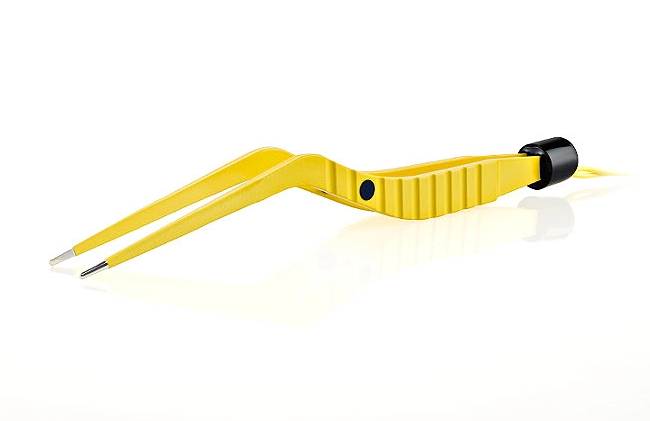The imperative for patient safety and operational efficiency in the modern operating room has driven innovation in surgical instrumentation. Single-use bipolar forceps have emerged as a crucial tool, offering significant advantages in minimizing cross-contamination risks, improving precision, and streamlining surgical workflows. This article delves into the pivotal role of single-use bipolar forceps in contemporary surgical practice, exploring their benefits, applications, and impact on patient care.

Single-Use Bipolar Forceps: Principles and Functionality
Forceps: Principles and Functionality
Bipolar forceps, including single-use bipolar forceps, are essential surgical instruments used for hemostasis and tissue dissection. Unlike monopolar forceps, which require a grounding pad, bipolar forceps deliver electrical current between two electrodes at the instrument's tips. This localized energy delivery allows for precise tissue coagulation and cutting, minimizing collateral damage. Single-use bipolar forceps are designed for single-patient use, eliminating the need for reprocessing. Their precise control makes single-use bipolar forceps indispensable across various surgical specialties, including:
1. General Surgery: Single-use bipolar forceps are employed in procedures like hernia repairs, appendectomies, cholecystectomies, and bowel resections for tissue dissection, blood vessel coagulation, and hemostasis.
2. Gynecology: Single-use bipolar forceps are utilized in laparoscopic surgeries, hysterectomies, fibroid removal, and sterilization procedures, where precision is crucial due to the proximity of sensitive organs.
3. Urology: Single-use bipolar forceps are used in procedures involving the kidneys, bladder, and prostate, such as prostatectomies, cystoscopies, and kidney stone removal, where minimizing bleeding is paramount.
4. Neurosurgery: Single-use bipolar forceps are crucial in delicate brain and spinal cord surgeries for precise coagulation of small blood vessels, reducing bleeding and neural tissue damage.
5. Cardiothoracic Surgery: Single-use bipolar forceps are employed in heart and lung surgeries for controlling bleeding and manipulating delicate tissues, often in confined spaces.
6. Plastic Surgery: Single-use bipolar forceps are used in procedures like facelifts, rhinoplasties, and breast reductions for precise tissue dissection and hemostasis, minimizing bruising.
The Advantages of Single-Use Bipolar Forceps over Reusable Instruments
While reusable bipolar forceps have been a surgical mainstay, single-use bipolar forceps offer distinct advantages:
1. Elimination of Cross-Contamination Risk: Single-use bipolar forceps are sterile and intended for one-time use, virtually eliminating the risk of transmitting infectious agents between patients. This is a critical advantage over reusable instruments, even with rigorous sterilization, as biofilms can be resistant to standard reprocessing methods.
2. Enhanced Precision and Control: Single-use bipolar forceps are often designed with improved ergonomics, offering surgeons greater control over tissue manipulation. This precision minimizes tissue trauma and can lead to better patient outcomes.
3. Streamlined Surgical Workflows: Single-use bipolar forceps eliminate the need for time-consuming and resource-intensive sterilization and reprocessing. This contributes to increased operating room efficiency and reduces turnaround times between procedures.
4. Cost-Effectiveness of Single-Use Bipolar Forceps: While the per-unit cost of single-use bipolar forceps might be higher, a comprehensive cost analysis often demonstrates long-term cost-effectiveness. This is due to the elimination of sterilization costs, maintenance, repairs, and the potential costs associated with treating surgical site infections.
5. Consistent Performance with Single-Use Bipolar Forceps: Single-use bipolar forceps are manufactured to stringent standards, ensuring consistent performance and reliability in every procedure. This eliminates the variability associated with reusable instruments that can degrade over time.
Single-Use Bipolar Forceps: Applications Across Surgical Specialties
Single-use bipolar forceps have become indispensable across various surgical fields:
1. Minimally Invasive Surgery (MIS): The precision and maneuverability of single-use bipolar forceps make them ideal for laparoscopic and other MIS procedures.
2. Electrosurgery: Single-use bipolar forceps are used in conjunction with electrosurgical units for cutting, coagulating, and dissecting tissues.
3. Vascular Surgery: Single-use bipolar forceps are employed for controlling bleeding during vascular procedures.
4. Ophthalmology: Single-use bipolar forceps are used in delicate eye surgeries for coagulating small blood vessels.
Environmental and Economic Considerations of Single-Use Bipolar Forceps
While the benefits of single-use bipolar forceps are clear, environmental and economic factors must be addressed. The increased use of disposable medical devices raises concerns about waste. Hospitals are exploring solutions:
Waste Reduction and Recycling: Implementing programs to minimize waste and recycle medical plastics and metals.
1. Sustainable Procurement: Sourcing single-use bipolar forceps from manufacturers committed to sustainability.
2. Biodegradable Alternatives: Researching biodegradable materials for single-use devices.
3. Economically, single-use bipolar forceps often prove cost-effective when considering the total costs associated with reusable instruments.
Conclusion: Single-Use Bipolar Forceps – A Key Component of Modern Surgical Practice
Single-use bipolar forceps represent a significant advancement in surgical instrumentation, offering a compelling combination of enhanced patient safety, improved efficiency, and cost-effectiveness. As surgery evolves, single-use bipolar forceps will play an increasingly important role in minimizing risks and optimizing workflows. Companies like Kangji Medical are crucial in developing high-quality single-use bipolar forceps, contributing to better patient outcomes and a safer surgical environment. Ongoing innovation will further enhance the benefits and mitigate the environmental impact of single-use devices.




Comments